Working out can definitely be more fun with a friend. It can also hold you accountable and make you push harder.
Plus, a friend can be all the equipment you need to get in a great full-body workout.
With these 20 Partner Exercises, you can build strength, get in a great cardio workout and even improve your coordination.
And if you are looking for a great Partner Workout, check out the ones at the bottom!
Partner Exercises
Most of these Partner Exercises require only a partner to do them. However, if you do have a med ball, resistance band or sliders/towels, we’ll show you how to use them for some fun partner drills!
Partner Get Up – The Partner Get Up is a great full-body exercise to build core and leg strength while also getting your blood pumping.

To do the Partner Get Up, stand facing your partner with your feet between hip-width and shoulder-width apart. Your feet can be slightly staggered if you want with the opposite foot forward to the hand you will grab your partner with. You may find you start with your feet together and then even step one foot forward as your partner lowers down. Hold your partner’s hand so that you are holding right to right or left to left.
Then, one partner will sit down on the ground and roll back onto their back. The partner standing will hinge over and bend their knees slightly to lower their partner down and be in a position to assist their partner in standing back up.
The partner on the ground will then come back up to standing without using their other hand to push off the ground. They will roll up and drive through their heels to come back up to a standing position. The standing partner will assist them in coming back up to standing by “pulling” them back up as much as needed.
Once the partner is standing again, the other partner will roll back and perform the get up. Keep alternating partner get ups on one side and then switch sides and hold hands with the other hand.
The more you pull your partner, the easier the move will be on their legs. Try to make each other work and move as quickly as possible.
Partner Pushes – If you want to work on core strength while doing some unilateral work to improve your chest, tricep and shoulder strength, then you need to do Partner Pushes. This is a great move to work your upper body if you don’t have weights or bands and don’t feel like doing the same old push ups.
Plus because this is a unilateral push, you can correct imbalances and really build core stability.

To do Partner Pushes, place your hand palm to palm with your partner’s so that it is right hand to right hand or left hand to left hand. Step the opposite forward into a strong staggered stance facing your partner. Make sure you are far enough apart that one of you can extend your arm fully while the other partner is back, but not so far apart that you can’t bring your hand back into your chest.
Then both of you should push into each other. You want to keep tension between you two the entire time you are doing this move. You want to make each other really work for every inch of movement. However, you do not want to resist so hard that the other person can’t move. There should be slow and steady movement back and forth.
Start with one partner’s hand at their chest and the other partner’s arm fully extended. The partner with their hand in should then push the other partner’s arm back and in as they straighten their own. The partner being pushed back should resist and apply pressure, but shouldn’t keep the other partner from being able to extend their arm.
Once the partner fully extends their arm, the other partner will push back.
Make sure as you each push and resist that you maintain a nice tall posture. Also, do not let your shoulder shrug as you push. Keep your shoulder down. Try to also keep your core engaged and only very slightly rotate as you press.
Complete pushes on one side for time or reps and then switch to the other side.
Partner Pulls – This is a great way to work your back, biceps and core with resistance even if you don’t have any weights. Partner Pulls are also a unilateral exercise so that you can work each side independently to correct imbalances.
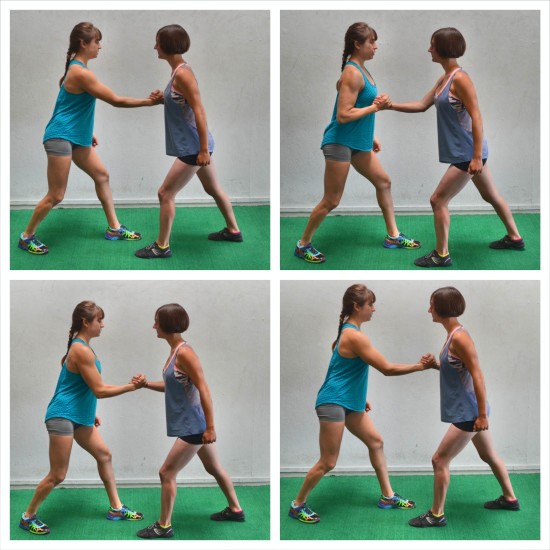
To do Partner Pulls, grab your partner’s hand (right to right and left to left) and step the opposite foot forward into a strong staggered stance facing your partner.
To make this move really work your upper body, you need to make sure that both of you are creating tension the entire time. You want to make each other really work for every inch of movement. However, you do not want to resist so hard that the other person can’t move. There should be slow and steady movement back and forth throughout the entire range of motion.
Start so that one person has their hand in by their body while the other partner’s arm is extended. Standing up nice and tall, the partner with the straight arm will begin to pull the other partner’s arm out straight as they resist the pull.
As soon as the partner’s arm is fully extended, they will start pulling back in toward their body while the other person resists. Make sure to resist enough to challenge each other, but not so much that you stall.
A slight rotation as you pull is fine, but you shouldn’t rotate a lot. Also do not round forward, lean back or shrug your shoulders as you pull. You want to pull in and drive your elbow down and back to feel not only your arm working, but also your back working.
Keep a nice tall posture and a slight bend in your knees for a nice strong stance. Make sure to really feel your back working.
Partner Crawl Under, Jump Over – If you want a cardio exercise that will work your body from head to toe, you need to do the Partner Crawl Under, Jump Over.
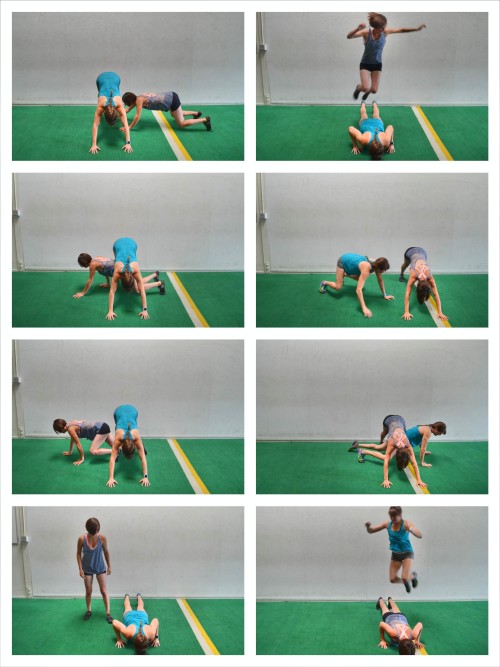
To do the Partner Crawl Under, Jump Over, one partner will set up in a pike/downward dog position. They should have their butt up in the air so that their partner has plenty of room to crawl under them. The other partner will start standing to their side.
The partner standing will then move down to the ground and crawl under the partner holding the pike position. When you crawl under, you should try not to touch your knees to the ground. Crawling with your knees on the ground will make the move easier. Crawl all the way under and through to the other side of your partner holding the pike and then come up to standing.
After the partner crawls all the way through, the partner in the pike will drop and hold at the bottom of a push up with their body in a nice straight line. You want to hold with your chest only a few inches off the ground. Holding at the bottom of a push up is very challenging. To make the move easier, just rest on the ground or even go down to your knees to hold the bottom of the push up. Make sure if you do hold in the push up, your body is in a nice straight line.
The partner standing will then jump over the partner at the bottom of the push up. Try to jump with both feet together; however, you can make the move easier by hopping over one foot at a time.
Once the partner has jumped over, they will then drop to the ground and set up in the pike position so that the partner on the ground can crawl under and then jump over. Keep alternating who crawls under and who holds the pike.
Partner Hamstring Curls – There really is no better move if you want to isolate and work your hamstrings and core than the Partner Hamstring Curls. I even prefer this hamstring isolation move to the machine hamstring curl because if you do it correctly it will not only toast your hamstrings, but also work your core.
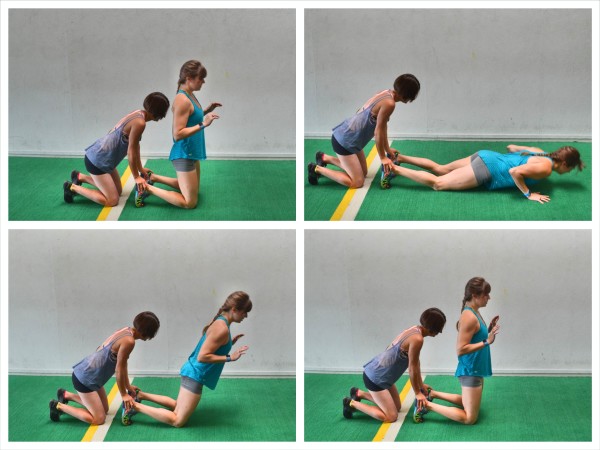
To do the Partner Hamstring Curl, one partner will kneel on the ground in front of the other with their feet flexed. The partner in back will hold down the heels/ankles of the front partner. The back partner will want to press their partner’s feet/ankles down hard to really help anchor them and assist them. This will help them more easily use their hamstrings to come back up.
Then the front partner will start kneeling nice and tall with their glutes engaged and abs braced.
They will then slowly lower themselves down forward, keeping their body in a nice straight line. Keep your hands up by your chest as if you are going to do a push up so that once you reach the ground you can catch yourself on your hands and use your arms to press yourself back up only as much as needed.
Once you lower down slowly and reach the ground, Ppush up off the ground as if doing a push up. Only push as hard as you need to assist your hamstrings in pulling you back up. Do not sit your butt back as you come back up. You want your body to move back up as one unit just as you lowered down.
Make your hamstrings do the work. Come all the way back up and repeat.
Beginners may start facing a wall. The wall will decrease their range of motion so that their hamstrings can work the entire time. To use the wall, face the wall and lower yourself forward/down to the wall and then use your hamstrings to curl back up to kneeling. By not going all the way down to the ground, the move should be easier and allow you to isolate your hamstrings and not turn it into only an upper body exercise.
Partner Reaction Lunges – This is a great way to make the basic front lunge a bit more challenging without using weights. With this move you are going to react and catch yourself in a lunge after your partner pushes you. It will force your core and legs to work to decelerate your body after being pushed forward.

To do the Partner Reaction Lunge, one partner will stand behind the other. The partner in back will “push” the front partner forward so that they have to react and catch themselves in a lunge.
If you are the back partner, start by pushing your partner forward on their upper back. Push them hard enough that they have to step forward into a lunge and react, but not so hard they lose their balance.
If you are the front partner, when you are pushed, step forward and sink into a lunge to decelerate and catch yourself from the push. Then drive back to standing, pushing off that front heel. Make sure to keep your chest up and core tight as you lunge. Also make sure you don’t go forward onto the ball of your foot or your toes. You want to land with your foot flat on the ground as you sink into the lunges.
Push back up to standing and then have your partner push you again. This time lunge with the other leg to catch yourself.
The “pushes” should be hard enough that the partner is challenged to react and catch themselves without being so hard that they completely lose their balance.
The partner being pushed must also make sure to wait for the push. Do not lunge before your partner pushes you.
The harder the push, the harder the move will be.
Partner Leap Frog – Have some fun while working your legs and getting your heart rate up with the Partner Leap Frog. This is a great way to change up Jump Squats and make them a bit more fun!
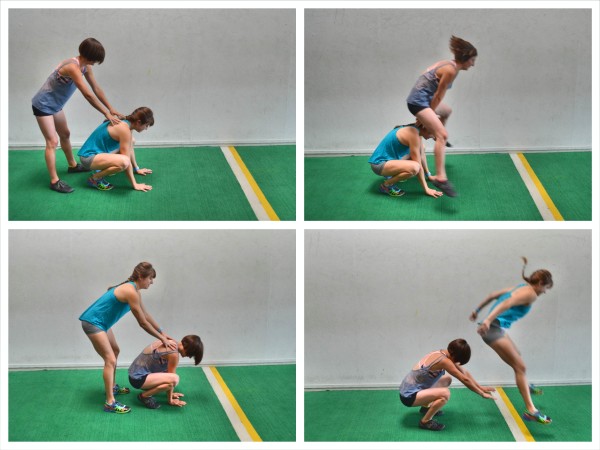
To do the Partner Leap Frog, one partner will start crouched on the ground on their hands and the balls of their feet. The other partner will stand behind their partner and place their hands on their partner’s shoulders.
Then pressing off their partner’s shoulders, the partner will jump over their partner crouched on the ground. They will jump over and land with soft knees and then sink into a crouch on the ground.
The partner that was crouched down will stand up and place their hands on their partner’s shoulders. They will then jump over their partner, pressing off their shoulders a bit to help them get over.
Try to really use your legs and only use your hands on your partner’s shoulders to assist. Do not completely rely on pushing off your partner.
Keep alternating jumps over each other. The lower the crouching partner gets, the easier the jump will be.
Try to move quickly and not rest between jumps.
Partner Leg Throws – If you want to challenge your abs and take Leg Lowers to the next level then you need to try Partner Leg Throws. This is a very advanced core exercise as it requires you to be able to really engage your core to protect your low back as you not only perform leg lowers, but leg lowers with resistance.
With this move, you are fighting to keep your legs off the ground as your partner throws them toward the ground. This requires you to really engage your core. If you feel this move in your low back, regress the move by bending your knees or even do single leg lowers with your partner lightly pushing your leg.
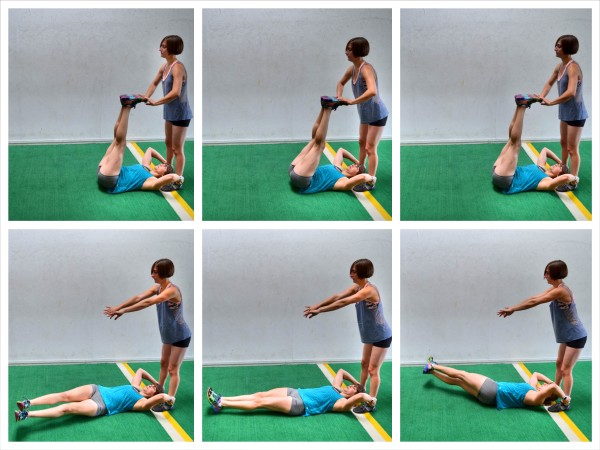
To do Partner Leg Throws, one partner will lie on their back on the ground with their partner standing right behind their head. The partner on the ground will reach back and grab the standing partner’s ankles.
The partner on the ground will then lift their legs up and back toward their partner behind them. Keep your legs straight and close together.
The standing partner will then grab their feet and “throw” their partner’s legs toward the ground. They can throw them straight ahead or angled to one side or the other. Mix it up and make them react to the throw.
Throw your partner’s legs hard enough that they have to fight to keep their heels up off the ground, but not so hard that they can’t control their legs and go crashing down.
When your legs are throw, engage your abs and decelerate the throw right before your heels touch the ground. Then use your abs to raise your legs back up to your partner. Do not let your legs bend and make sure to keep your legs close together as your legs get thrown.
Do not let your low back engage as you fight to keep your heels up off the ground or when you raise your legs back up.
Remember, this is an advanced move. Beginners may even want to start with a variation of the Pelvic Tilt Progression before attempting this partner move.
Partner Wall Push – A great way to build core stability and strength is with the Wall Push. And when you have a partner with you to do this move, you make it even more challenging and force your core to work even harder.
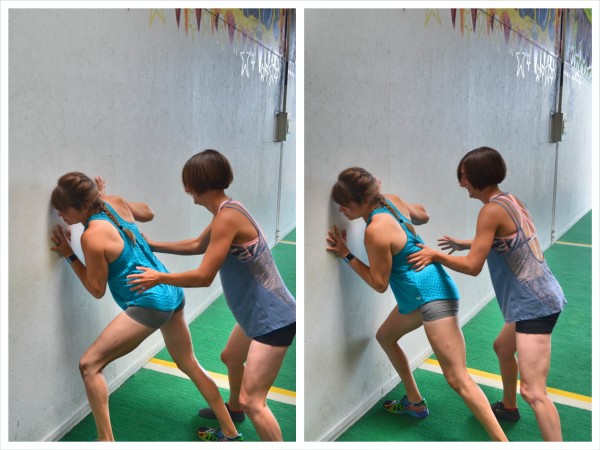
To do the Partner Wall Push, one partner will stand facing the wall. They will set up fairly close to the wall with their feet in a staggered stance and their hands against the wall.
They will then press into the wall as if trying to drive the wall back. Their arms should be bent as if they are pressing at the bottom of a push up and they should get close to the wall with their feet staggered back to help them push in.
As they hold and drive hard into the wall, their partner will “push and pull” them to force them to stabilize and keep pressing into the wall. By pushing and pulling your partner, you are making sure they are driving into the wall as hard as they can and not simply leaning into the wall.
If you are pushing into the wall, do not let your partner move you as they push and pull you. You want to engage your core and drive hard into the wall to help you stay still and balanced.
If you are pushing and pulling your partner as they hold, make sure to put enough behind your pushes to force them to have to work, but don’t push them so hard that they keep losing their balance.
Partner Bull Dogs – Work your core and especially your shoulders, abs and quads with the Bull Dog Hold. And just like with the Wall Push, you can make it more challenging by having a partner there to push you around a bit!
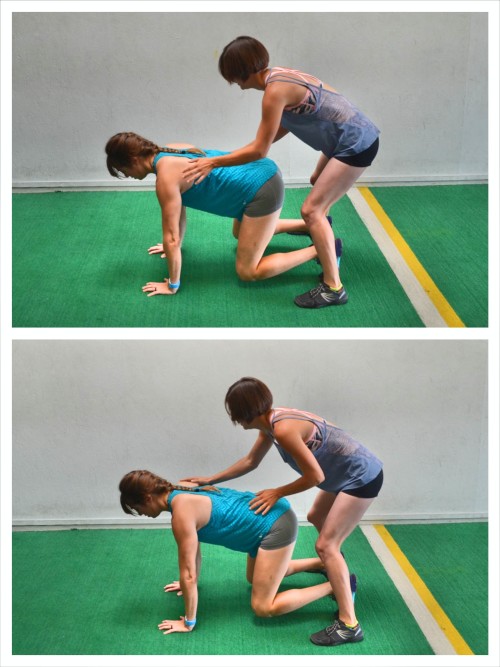
To do Partner Bull Dogs, one partner will set up in the Bull Dog position. To set up in the Bull Dog position, one partner will start on their hands and knees with their knees under their hips and their hands under their shoulders. They will then flex their feet and lift up onto the balls of their feet and their hands. They will hold in this position with their knees only an inch or so off the ground.
While one partner holds in this Bull Dog position, the other partner will push and pull the partner in the Bull Dog Hold, challenging them to stabilize in every direction just like they did with the Partner Wall Push. Do not pull your partner over but make sure they have to really work to stabilize.
Make sure that as you hold the Bull Dog position, you brace and try to stay as still as possible as they push you.
Partner Crawls – The Wheelbarrow – Work your entire body with the Wheelbarrow crawl. This is a great way to strengthen your shoulders, arms, abs, glutes and even your legs. However, this is a more challenging crawling variation and requires a lot of core strength to prevent your hips from rotating all over the place. Beginners may want to start with the Basic Crawl or even some of these other crawling variations first.
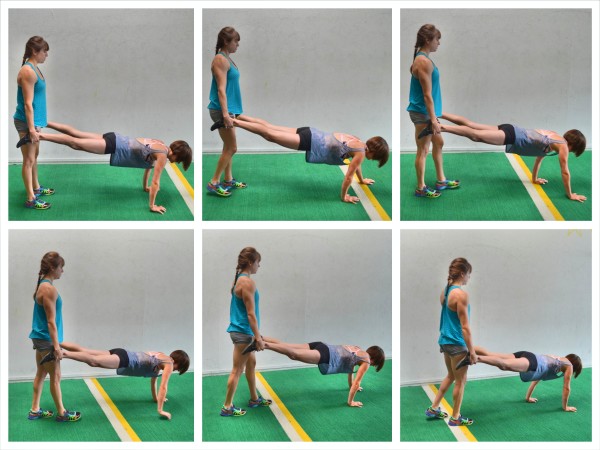
To do the Partner Wheelbarrow Crawl, one partner will move to the ground on their hands and knees while their partner stands behind them. The standing partner will then grab the feet/ankles of the partner on the ground as the partner on the ground situates their hands under their shoulders and moves into a plank position with their legs lifted. Make sure that the partner crawling starts with their arms straight and their body in a nice straight line. Their hips shouldn’t drop toward the ground and their butt shouldn’t go up in the air.
The partner on the ground will then begin to crawl forward, stepping forward with their hands while they keep their legs straight and their core braced so that their hips don’t swing a lot side to side as they crawl. Also, make sure their body stays in a nice straight line as they crawl.
The standing partner will walk forward as their partner crawls forward. They need to make sure to stand up tall and not hunch forward or lean over as they walk. They will support their partner as they crawl and hold their legs up and straight.
Partner Sleds – Partner Sleds are a great way to work your legs (especially your quads!) and your core even if you don’t have a sled. And the best part about this move is that both partners will be working the entire time even as one person acts as the “sled.”

To do the Partner Sled, one partner will stand on sliders (Valslides) or towels. The partner on the sliders will make sure their feet are fully on the sliders and then will squat down, sitting their butt back while keeping their chest up.
The other partner will stand facing them and grab their hands. Both partners will straighten their arms out as they hold hands.
The partner not on the sliders will then begin to walk/run backward, pulling their partner along while their partner stays in the squat with their chest up. The partner walking/running backward also needs to keep their chest up and not round forward as they pull.
Start slow and gain speed as you run backward so your partner isn’t pulled forward off the sliders. The partner on the sliders will have to make sure to sit back as their partner goes backward to stay balanced and allow their partner to pull them.
Go as fast as you can while still working together.
Both partners need to engage their cores and keep their chests up. Do not round forward. The partner on the slider also needs to make sure to squat down and not simply lean forward and let their butt go up in the air. Maintain a nice low squat, about parallel to the ground. Also do not let your knees cave in as you hold the squat.
Both partners will, and should, feel their quads working. Once one partner pulls, switch positions and have the other person be the sled on the sliders.
Partner Drags – Partner Drags are another great cardio and leg (quad especially!) and core exercise; however, unlike the Partner Sleds where both partners are really working, the Drags really only force the person dragging to work hard.

To do Partner Drags, one partner will stand in front of the other with their back to their partner. The partner in front will step onto sliders, Valslides or towels. They can then cross their hands over their chest as their partner behind them reaches around to hold them under their arms.
The front partner will then lean back into their partner as the back partner begins to walk/run backward. Both partners should brace their abs as they move and the back partner needs to make sure they don’t round forward as they drag their partner.
Run/walk backward as quickly as possible dragging your partner. Then switch roles.
Partner Carries – If you want a challenging weighted carry exercise, then Partner Carries is a move you need to include in your workouts. Weighted Carries are a great way to work your entire body and strengthen your core and legs. However, they are a very advanced move and should not be attempted especially if you have low back pain. You need to be able to engage your core correctly and arrange your partner over your shoulders if you are going to attempt this move.
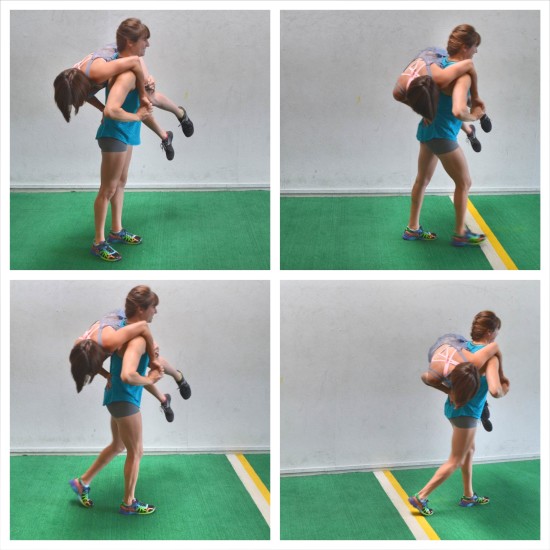
To do Partner Carries, one partner will need to pick up the other. To pick up your partner, have them face you while you are standing sideways to them. You will then reach through their legs and hook your arm around and up. As you reach through, you should have their other hand over your back and in your other hand. Arrange your partner over your back right up by your shoulders. Brace your core and have your partner put their bottom free hand on your low back to help you brace your core. Get them situated up high on your back, over your shoulders, and lift them up.
Then begin to walk forward staying up nice and tall with your core braced.If you cannot perform this carry, you can also perform a partner drag instead. Make sure you do not start to round or lean forward. If you do, you will load your low back.
Partner Med Ball Drills – Med ball drills can be great partner cardio exercises. Below are three different partner drills you can do using a med ball.
- Chest Pass and Shuffle – The Chest Pass and Shuffle is a great exercise to work your chest, shoulders, core and legs. It also forces you to move in numerous planes of motion at once since you have to shuffle laterally as you pass the ball back and forth. To do the Chest Pass and Shuffle, hold the med ball in both hands at your chest and face your partner. Both of you should begin to shuffle laterally as the first partner passes the ball to their partner with a chest pass, pressing the ball straight out from their chest and across to their partner. The partner will then catch the ball and pass it back as they both keep shuffling quickly. Stay close enough to each other that the passes are quick as you both shuffle quickly together. Shuffle back and forth while doing as many chest passes as you both can. Make sure to shuffle both directions as you pass the ball.
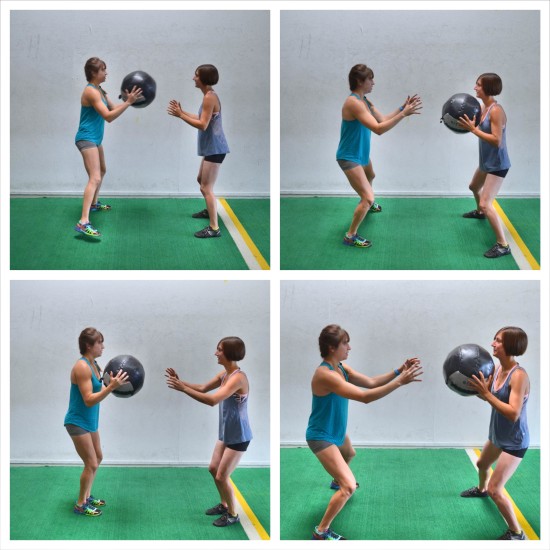
- Rotational Throws – When we workout, we should move in every plane of motion to strengthen our body for every day life. That is why it is important to include rotational exercises in our workout routines. Rotational Med Ball Throws are a great way to strengthen your core with rotational movement. To do Rotational Throws, both partners should start standing with their sides to each other. Their feet can be slightly staggered. They should be far enough apart to challenge each other with the throws, but not so far apart that they can throw it quickly and directly to the other person. One partner will start holding the ball in both hands. That partner will reach the ball back toward the hip of their back foot. They will then rotate open toward their partner as they throw the ball underhanded to their partner. The partner will then catch the ball and swing it back toward their back hip before again throwing it underhanded to their partner. Make the throws powerful and quick. You can choose to stay on one side or you can alternate sides.
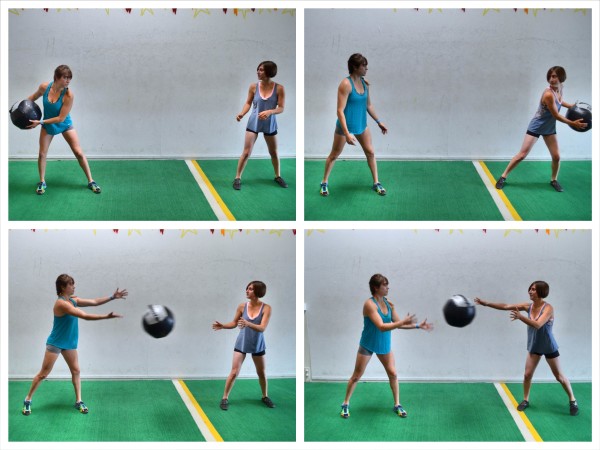
- Sit Up and Throw – The Sit Up and Throw is a great move to work your triceps, lats and core. It is also simply a fun sit up variation you can do with a partner! It is however a more challenging move so make sure to start with a light ball. To do the Sit Up and Throw, sit on the ground with your legs out wide in front of you and your knees slightly bent. Your partner should be seated in the same fashion in front of you. Make sure you are far enough apart to challenge each other with the throw as you sit up. One partner will start holding the ball in both hands. They will then lie back on the ground and extend the ball overhead. As they sit up, they will perform an overhead throw, throwing the ball to their partner. Sit all the way up and follow through the throw. The other partner will be seated and catch the ball. As they catch the ball, they will lie back down and reach the ball back overhead. From there, they will perform an overhead throw as they sit up. Do not sit up and then throw or perform a chest pass. This is an overhead throw performed as you sit up. Beginners may even need to start with simply a seated overhead throw if they can’t sit up as they throw.

Partner Shadowing Drills – If you want to improve your coordination and reaction time, then you need to include shadowing drills in your workout routine. Plus these can be a fun way to get your heart rate up as you work to improve your mind-body connection.
There are two different types of Partner Shadowing Drills you can do – Footwork Shadowing and Hand Shadowing.
- Footwork Shadowing Drill – With the Footwork Shadowing Drills, you will improve you reaction time while getting your heart rate up. With these drills you can move in any and every direction. To do Footwork Shadowing Drills, one partner will follow while the other leads. Your goal is to challenge your partner to follow you and react quickly without moving so fast in such short movements that they can’t follow at all. One partner will start leading while the other person follows. The leading partner should try to change directions quickly and keep the space they use small so that the other partner is forced to make quick changes. Back pedal, shuffle, sprint forwards – move in any and every direction and challenge your partner to move quickly and follow you. After one partner leads, the other partner should take charge.

- Hand Shadowing Drills – With Hand Shadowing Drills, you are again working on your coordination and improving your mind-body connection; however, this time your upper body and core are really working to react and follow. To do Hand Shadowing Drills, both partners will face each other. They can either put the backs of their hands together or their palms together. Whichever you do, make sure your hands are firmly pressed together. If you don’t have tension, you will more easily lose your partner as you follow. One partner will be the leader. They will move their arm up, down and side to side. They should even bend their legs to get low and use their whole body to move without really moving their feet anywhere. The partner following needs to follow and keep their hand pressed against their partners. Move quickly and move in every direction. Force your partner to work to follow, but don’t move so quickly they are constantly losing you. Make sure that each partner leads. Also make sure to work both sides!
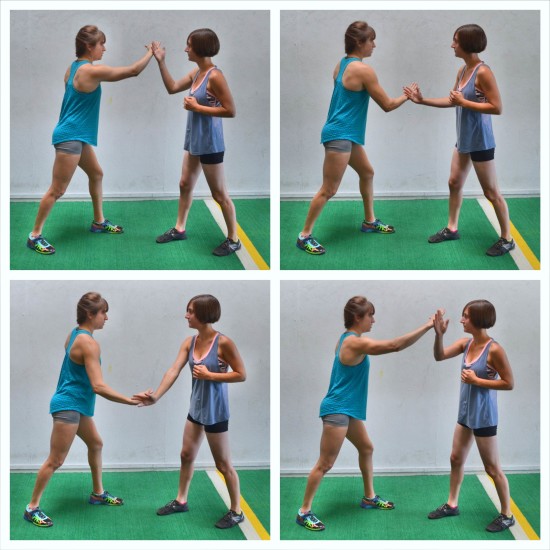
Partner Resistance Band Drills – If you have a resistance band, you can also use that to get in a great workout with a partner. With the 3 Partner Resistance Band Moves below, you can really work your core as well as your shoulders and even your glutes.
- Band Seesaw – The Band Seesaw is a great move to work your shoulders, core, glutes and even your hamstrings. To do the Band Seesaw, both partner will stand facing each other with their feet about hip-width apart. They will each hold an end of the band and set up far enough apart that there is tension in the band; however, do not get so far apart that you can’t pull the band up overhead. Then one partner will hinge over, pushing their butt back as they lean over and pull the band back between their legs. Your knees will bend slightly as you pull it back, but you are not squating down. You want to hinge at the hips and push your butt back as you pull the band back between your legs with straight arms. Make sure that as you hinge, your back is flat. While one partner hinges over, the other partner will pull the band up and overhead. As you pull the band up overhead, keep your arms straight. Engage your glutes and stand up nice and tall. Do not arch your low back as you pull overhead. Try to stand up tall and extend your arms. Then, moving together and keeping tension in the band, both partners will switch and perform the other movement. As they switch the band will move like a “seesaw.” The partner that was hinging over will now pull the band back overhead to resist the partner that is moving from overhead to the hinge. Again, move together and make sure there is tension in the band at all times.

- Band Circles – Work your abs, upper back, shoulders and glutes with this Resistance Band Partner Move. This is a great move to build core stability as well. To do Band Circles, both partners will stand side by side with the band held in front of them at their chests. Stand far enough apart that there is tension on the band, but not so much that you can’t circle it out to both sides. Both partners will then press the band out from their chest with their arms out straight. Make sure to keep your chest pressed out and your shoulders down. Do not shrug. Then one partner will pull the band to the right with their arms straight. The other partner will follow as the first partner draws a big circle with the band. The partner following will want to resist a little as they circle. You want tension on the band at all times. Move slowly as you circle and brace your abs. Create circles one way and then reverse the circles with the other partner leading. Try to move together at the same pace although it is ok if you get off a little. You can add in a squat too as you circle to make the circles bigger and even work your legs a bit more.
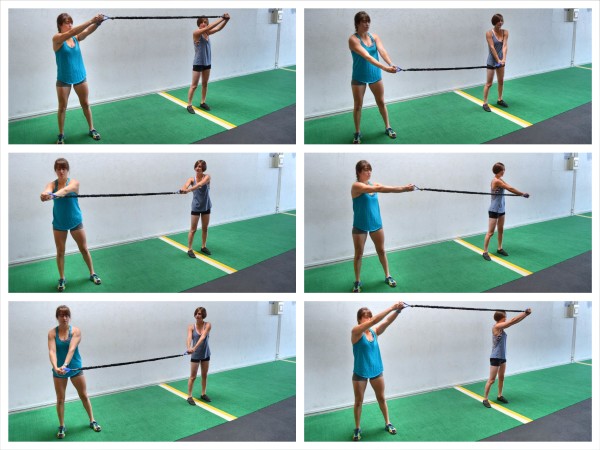
- Band Stability Press with Rotation – Build core stability and strength with this move. The Band Stability Press with Rotation is also one of the few moves you can do to work on rotational strength and anti-rotational strength. To do the Band Stability Press with Rotation, the partners will each hold an end of the band in their hands while facing perpendicular to each other. One partner will face the other while the other will stand sideways to their partner. The partner standing sideways will hold the band out in front of them at chest height with their chest pressed out and their shoulders down and back. Their arms will stay out straight in front of them and they will resist the rotation, trying to keep their hands straight out from the midline of their chest. They will have to fight their partner trying to pull them to rotate. The partner facing them will force them to work to stabilize by rotating side to side. As the partner rotates from side to side, they will pull the band from hip to hip, pivoting their back foot while keeping their arms straight. They want to make sure to press their chest out and maintain a nice tall spine as they use their core and legs to help power the rotation. Move quickly with the rotation and force your partner to work to stabilize; however, don’t move so quickly or forcefully that your partner can’t resist the rotation. Also, make sure their is tension in the band the entire time. Make sure both partners rotate and stabilize. Also make sure you do the stabilization facing both directions to work both sides.

Partner Resisted Sprints – If you don’t have much room to run or if you want to seriously toast your legs and core while getting your blood pumping, you need to try Partner Resisted Sprints. This is also a great way to work on power and speed and even your sprinting form.
To do Partner Resisted Sprints, wrap a band or towel around one partner’s hips or use a harness. The other partner will stand behind the partner sprinting, holding the ends of the band, towel or harness. The front partner will then begin to sprint. They will lean forward into the band and sprint, driving their knees up as they swing their arms from “cheek to cheek.” As they sprint against the band, their partner will pull back and slowly follow them. This isn’t about sprinting forward quickly, but about lots of quick knee drives as your partner allows you to slowly move forward. Move as quickly as you can using your arms and the rotation of your core as you quickly drive your knees. Do not round or hunch forward as you sprint. Also, do not start chopping vegetables with your arms. Drive your elbows back and swing your arms from about your cheek to your hip. Partners should also allow their partner to sprint forward slowly. Do not hold them in place or allow them to move forward too quickly. Beginners may need to slow down the knee drives and do more of a march.
For a demonstration of Partner Resisted Sprints, see the video (it’s at about time 5:03).
Partner Workouts:
Here are some great Partner Workouts you can do using these moves.
Workout Library Partner Workouts:
- The Partner Strength and Cardio Circuit – This workout uses moves like the Partner Get Up and Partner Crawl Under, Jump Over to get your blood pumping while also working your core with the Partner Leg Throws.
- Partner Coordination Drills – Improve your coordination while getting in a great cardio-core workout with this Partner Workout!
- The Resisted Sprint and Core Workout – Work those abs and burn tons of calories with this Partner Resisted Sprint Workout!
- The Partner Outdoor Workout – Play around with the Wheelbarrow and Leap Frog in this partner workout.


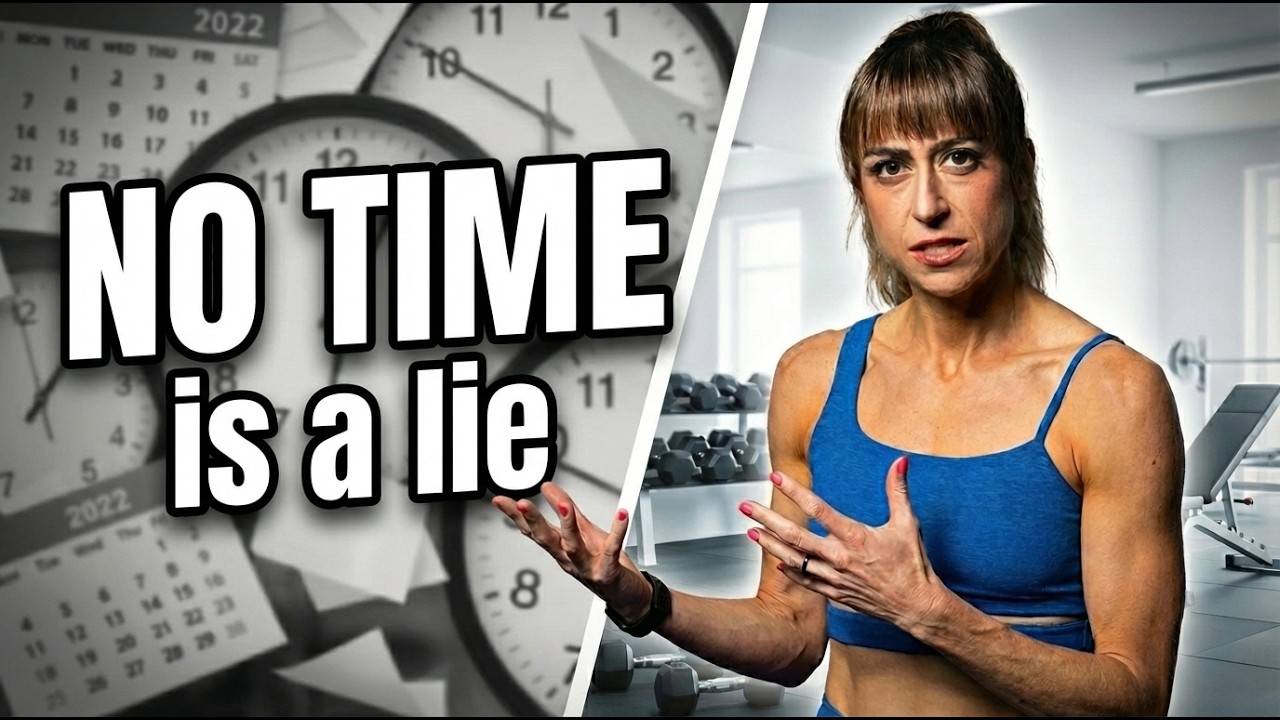
fantastic and elaborate workouts. i have never seen some of these which seems a ton of fun. thank you
Glad you like them!
Thank you a lot for the inspiring exercises! 🙂
I will try out
Amazing work/article =)
Thanks
Glad it helps!
This is great! Thank you! Gives my partner and I new idwas to use in class!
So glad it helps!
Thank you, it’s really nice and helpful!
So glad it helps!